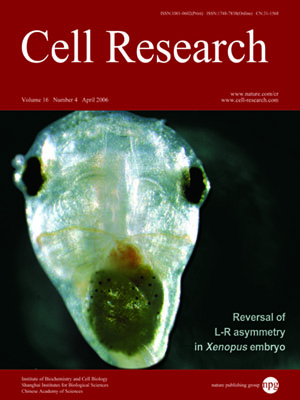
Volume 16, No 4, Apr 2006
ISSN: 1001-0602
EISSN: 1748-7838 2018
impact factor 17.848*
(Clarivate Analytics, 2019)
Volume 16 Issue 4, April 2006: 329-336
ORIGINAL ARTICLES
Molecular and phenotypic characterization of human amniotic fluid cells and their differentiation potential
Patrizia Bossolasco, Tiziana Montemurro, Lidia Cova, Stefano Zangrossi, Cinzia Calzarossa, Simona Buiatiotis, Davide Soligo, Silvano Bosari, Vincenzo Silani, Giorgio Lambertenghi Deliliers, Paolo Rebulla, Lorenza Lazzari
Fondazione Matarelli, 20121 Milan, Italy; Cell Factory, Centro di Medicina Trasfusionale, Terapia Cellulare e Criobiologia, Fondazione IRCCS Ospedale Maggiore Policlinico, Mangiagalli e Regina Elena, 20122 Milan Italy; Dipartimento di Neurologia e Laboratorio di Neuroscienze - Centro 揇ino Ferrari�, Universit� degli Studi di Milano - IRCCS Istituto Auxologico Italiano, 20122 Milan, Italy; Dipartimento di Anatomia Patologica, Ospedale San Paolo, 20142 Milan, Italy; 5Ematologia 1, Centro Trapianti di Midollo, Ospedale Maggiore IRCCS Universit� degli Studi di Milano, 20122 Milan, Italy
Correspondence: Lorenza Lazzari(cbbank@policlinico.mi.it)
The main goal of the study was to identify a novel source of human multipotent cells, overcoming ethical issues involved in embryonic stem cell research and the limited availability of most adult stem cells. Amniotic fluid cells (AFCs) are routinely obtained for prenatal diagnosis and can be expanded in vitro; nevertheless current knowledge about their origin and properties is limited. Twenty samples of AFCs were exposed in culture to adipogenic, osteogenic, neurogenic and myogenic media. Differentiation was evaluated using immunocytochemistry, RT-PCR and Western blotting. Before treatments, AFCs showed heterogeneous morphologies. They were negative for MyoD, Myf-5, MRF4, Myogenin and Desmin but positive for osteocalcin, PPARgamma2, GAP43, NSE, Nestin, MAP2, GFAP and beta tubulin III by RT-PCR. The cells expressed Oct-4, Rex-1 and Runx-1, which characterize the undifferentiated stem cell state. By immunocytochemistry they expressed neural-glial proteins, mesenchymal and epithelial markers. After culture, AFCs differentiated into adipocytes and osteoblasts when the predominant cellular component was fibroblastic. Early and late neuronal antigens were still present after 2 week culture in neural specific media even if no neuronal morphologies were detectable. Our results provide evidence that human amniotic fluid contains progenitor cells with multi-lineage potential showing stem and tissue-specific gene/protein presence for several lineages.
Cell Research (2006) 16:329-336. doi:10.1038/sj.cr.7310043; published online 13 April 2006
FULL TEXT | PDF
Browse 2008


